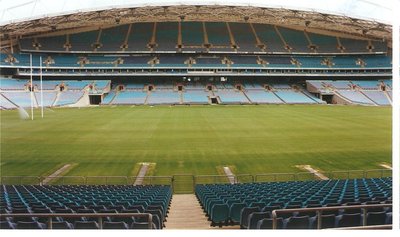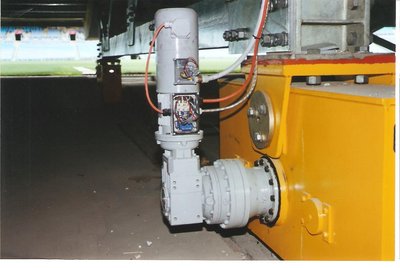Bonfiglioli drives State of Origin fans wild
Tuesday, 16 July, 2013
Some of the best seats in the house at this year’s State of Origin rugby league matches at ANZ Stadium on 5 June and 17 July were occupied by fans who were probably unaware of the industrial gearbox engineering that brought them closer to the spectacle.
Bonfiglioli combination helical/planetary technology - of a type typically used in resources, manufacturing and materials handling - is incorporated to a drive system that rolls forward 500 tonne sections of seating to give wildly enthusiastic fans a better view of events such as the State of Origin, rugby union tests and soccer matches attracting total attendances of 80,000 and more.

The 90 x 30 m sections of grandstand on each side of the ground are rolled forward 15.575 metres before each event, taking less than half an hour to move the distance required to put about 7500 privileged fans on each section much closer to the sidelines and the action.
“The scale of the job and the technology involved was comparable with some of the biggest materials handling tasks ever undertaken in Australian manufacturing or mining, where you sometimes might have to move massive machinery of similar weight and proportion,” said Bonfiglioli Transmission (Australia) Ltd Managing Director Malcolm Lewis.
The Multiplex project - which has brought spectacular action closer for millions of fans since the original installation - involved a high degree of technical innovation in the production of a series of 28 gearboxes to operate in two banks of 14 driving bogies for the mobile building structure. Instrumental in the design and installation were Eilbeck Cranes, which specified the Bonfiglioli drives involved, and Control Techniques, which worked with Bonfiglioli to resolve the technical challenges in cooperation with Structural Systems.

Each gearbox features a 1.1 kW 4-pole electric brakemotor driving an A series helical gearbox combined with a compact planetary Trasmital gearbox. The 105 kg combination provides high torque within a restricted space, offering a highly cost-efficient and compact installation compared with a much bulkier alternative weighing 261 kg.
“The drives operate with a number of technologically interesting features, including electronic encoders linked to PLC-controlled variable frequency drives. This arrangement functions to ensure all the motors operate in unison, so the bogies drive smoothly, without imparting any discordant stresses into the structure,” says Lewis.
“The Bonfiglioli brakemotor involved was also fitted with a ventilated servo, for ongoing reliability within a restricted space, where maintenance access could be an issue. This is important in an installation that has now been proven in service for some 10 years.
“The ventilation was important to ensure reliability, because the drives, controlled by the variator, do not run at their constant design speed - a condition which, without the ventilation, can produce heat.”
A final feature of the arrangement was a microswitch built into the brakemotor circuit to ensure all brakes are released before start-up.
Lewis says the project illustrated the many inputs that go to make up a large-scale industrial motors and drives project - including product range, engineering innovation and ability to deliver from quality-controlled facilities within Australia.
“In-house engineering and backup service is very important to major customers, who are going to depend on you to respond quickly to their design brief and ensure ongoing support of their installation.
“This confidence factor is vital in production circumstances, where the cost of the drives is just one component among many, but where failure could be disastrous,” said Lewis.
Hysteresis in pressure calibration: what you need to know
Pressure calibration is crucial for ensuring the accuracy and reliability of process instruments...
Heat exchangers expand ginger beer production in Bundaberg
Bundaberg Brewed Drinks outgrew its production facility, so ensuring the equipment in its new...
Sampling gases and volatile liquids: essential strategies
Following gas sampling best practices can improve product output and reduce fugitive emissions.







